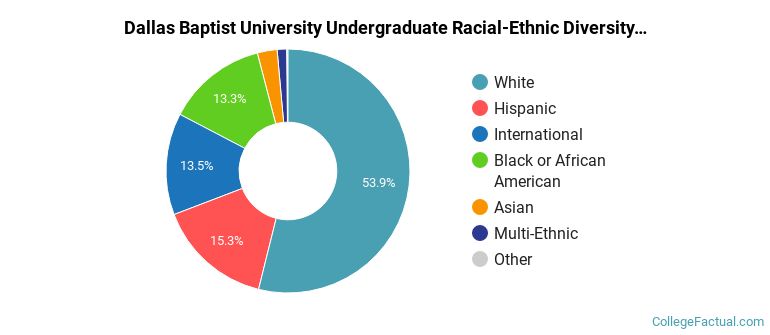 by our College Data Analytics Team
by our College Data Analytics TeamDBU total enrollment is approximately 4,247 students. 2,283 are undergraduates and 593 are graduate students.
Male/Female Breakdown of Undergraduates
The full-time DBU undergraduate population is made up of 58% women, and 42% men.

For the gender breakdown for all students, go here.
DBU Racial/Ethnic Breakdown of Undergraduates

| Race/Ethnicity | Number |
|---|---|
| White | 1,411 |
| Hispanic | 389 |
| Black or African American | 157 |
| International | 122 |
| Unknown | 91 |
| Asian | 52 |
| Multi-Ethnic | 48 |
| Native Hawaiian or Pacific Islander | 5 |
See racial/ethnic breakdown for all students.
Male/Female Breakdown of Graduate Students
About 59% of full-time grad students are women, and 41% men.

For the gender breakdown for all students, go here.
DBU Racial-Ethnic Breakdown of Graduate Students

| Race/Ethnicity | Number |
|---|---|
| International | 237 |
| White | 195 |
| Black or African American | 79 |
| Hispanic | 47 |
| Unknown | 15 |
| Asian | 13 |
| Multi-Ethnic | 5 |
| Native Hawaiian or Pacific Islander | 1 |
See racial/ethnic breakdown for all students.

| Race/Ethnicity | Number |
|---|---|
| White | 2,220 |
| Hispanic | 619 |
| International | 545 |
| Black or African American | 518 |
| Unknown | 161 |
| Asian | 104 |
| Multi-Ethnic | 59 |
| Native Hawaiian or Pacific Islander | 8 |

There are approximately 2,503 female students and 1,744 male students at DBU.
DBU ranks 1,241 out of 2,183 when it comes to geographic diversity.
10.25% of DBU students come from out of state, and 0% come from out of the country.

The undergraduate student body is split among 18 states (may include Washington D.C.). Click on the map for more detail.

| State | Amount |
|---|---|
| Texas | 473 |
| California | 8 |
| Arkansas | 7 |
| Florida | 5 |
| Colorado | 4 |
Students from 61 countries are represented at this school, with the majority of the international students coming from China, India, and South Korea.
Learn more about international students at DBU.
A traditional college student is defined as being between the ages of 18-21. At DBU, 39.25% of students fall into that category, compared to the national average of 60%.

| Student Age Group | Amount |
|---|---|
| 35 and over | 1,158 |
| 18-19 | 1,021 |
| 20-21 | 968 |
| 22-24 | 756 |
| 25-29 | 662 |
| 30-34 | 416 |
| Under 18 | 0 |
Footnotes
*The racial-ethnic minorities count is calculated by taking the total number of students and subtracting white students, international students, and students whose race/ethnicity was unknown. This number is then divided by the total number of students at the school to obtain the racial-ethnic minorities percentage.
References
Department of Homeland Security Citizenship and Immigration Services
Image Credit: By Regrothenberger under License
Learn more about how College Factual creates their Diversity Rankings.